| 1 | Gulf War oil spill
Oil spilled: 546,000 - 1,500,000 tonnes
In gallons: 168,168,000 - 462,000,000
In barrels: 4,002,180 - 10,995,000
Date: 21 Jan 1991 - May 1991
Location: Persian Gulf
Type: Oil wells
Cause: War
| Enormous amounts of oil were spilled into the Arabian Gulf when the Iraqi Army occupying Kuwait began destroying tankers, oil terminals, and oil wells late in January 1991.
The slick reached a maximum size of 160 by 65 kilometers (100 by 40 miles) and the oil had a devastating effects on coral, fish and shellfish in the Gulf.
Approximately 30,000 seabirds were killed directly by exposure to oil and 1,300 kilometers (800 miles) of coastlines in Kuwait and Saudi Arabia were oiled. Close to half of the coral of the region suffered effects, including coral bleaching, and hundreds of square kilometers of seaweed fields were damaged. Endangered animals such as the Dugong and sea turtles are also suspected to have suffered population losses.
In addition, the black oily rain from the fallout of hundreds of oil wells set aflame during the war might have nearly doubled the amount of oil spilled directly into the Gulf.
References: [1] [2] [3] | 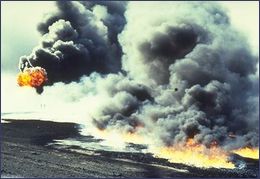
Bergan oil field fires, Kuwait 1991. (NOAA) |
| 2 | BP Deepwater Horizon
Oil spilled: 400,000 - 700,000 tonnes
In gallons: 123,200,000 - 215,600,000
In barrels: 2,932,000 - 5,131,000
Date: 20 Apr 2010 - 15 Jul 2010
Location: Gulf of Mexico
Type: Oil well
Cause: Blowout
| The Deepwater Horizon offshore drilling rig suffered a blowout at 9:45 in the morning of April 20, 2010. Of the 126 workers that were on the rig at the time 11 died in the resulting explosions. The rig burned for two days, finally sinking on April 22nd. Shortly thereafter it was found that the wellhead, on the ocean-floor 1,500 meters below, had been damaged and was leaking oil into the water. The first estimates of the spill rate were at 1,000 barrels per day, later estimates during May and June once underwater footage of the leaking well had been released moved the figure from 5 to 25 thousand barrels per day, and finally to 35-60 thousand barrels per day. This is equal to an Exxon Valdez disaster every four to seven days. The Ixtoc I oil well in the southern Gulf of Mexico which suffered a similar blowout in 1980 took nearly a full 10 months to be capped, and several attempts by BP to stop the Deepwater Horizon flow failed before it could finally be contained on July 15.
The oil slick spread quickly over the ocean surface, covering 1,500 square kilometers (580 sq miles) by April 25 and over 6,500 square kilometers (2,500 sq miles) by the beginning of May. Hundreds of kilometers of the Louisiana shoreline was contaminated, including several wildlife refuges important for sea turtles as well as hundreds of species of birds. Tar balls from the spill also reached beaches and islands in Mississippi, Alabama, Florida and Texas.
References: [1] [2] [3] [4] | 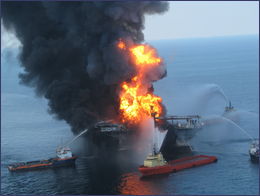
The Deepwater Horizon rig on fire before sinking. (Wikipedia) |
| 3 | Ixtoc I oil well
Oil spilled: 454,000 - 480,000 tonnes
In gallons: 139,832,000 - 147,840,000
In barrels: 3,327,820 - 3,518,400
Date: 3 Jun 1979 - 23 Mar 1980
Location: Gulf of Mexico
Type: Exploratory oil well
Cause: Drilling error, blowout
| The Ixtoc I oil well was a 2 mile deep exploratory drilling site. A blowout of oil and gas out of the well ignited on June 3rd, 1979 causing the platform to catch fire. After the burning platform collapsed there were great difficulties controlling the well, which continued to leak 10,000 - 30,000 barrels per day into the Gulf of Mexico until it was finally capped almost 10 months later.
The ocean currents carried much of the spill towards Texas and in total 260 kilometers (162 miles) of U.S. beaches were oiled. Marshes, mangroves and sand beaches - including some of the few remaining nesting sites for the critically endangered Kemp's Ridley sea turtle - were affected.
References: [1] [2] [3] | 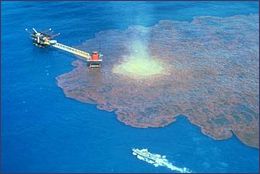
IXTOC I well blowout. (NOAA) |
| 4 | Atlantic Empress / Aegean Captain
Oil spilled: 276,000 - 287,000 tonnes
In gallons: 85,008,000 - 88,396,000
In barrels: 2,023,080 - 2,103,710
Date: 19 Jul 1979 - 2 Aug 1979
Location: Trinidad and Tobago
Type: Oil tanker
Cause: Ship collision
| The Atlantic Empress collided with the Aegean Captain in the evening of July 19th, 1979 in the Caribbean Sea 10 miles off Tobago. The Atlantic Empress (carrying 276,000 tonnes of crude oil) caught fire, as did the bow section of the Aegean Captain (carrying 200,000 tonnes of crude oil) and 26 crew members were killed. While the fire on the Aegean Captain could be brought under control the Atlantic Empress burned until August 3rd, when it sank after being towed to deeper water.
No significant shore pollution was recorded on the islands in the area and it appears the spill never reached land. However, no full impact study was ever carried out.
References: [1] [2] [3] | 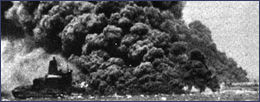
The Atlantic Empress burning. (CTX) |
| 5 | Fergana Valley oil spill
Oil spilled: 259,000 - 285,000 tonnes
In gallons: 79,772,000 - 87,780,000
In barrels: 1,898,470 - 2,089,050
Date: 2 Mar 1992 - May 1992
Location: Uzbekistan
Type: Oil well
Cause: Blowout
| A blowout occurred at oil well #5 in Mingbulak, Uzbekistan on March 2nd 1992. The uncontrolled flow of oil caught fire and continued for about 2 months, at an estimated rate of 35,000 to 150,000 barrels per day.
The surrounding farmland was polluted and residents in the area had to be evacuated.
References: [1] [2] | 
|
| 6 | ABT Summer
Oil spilled: 260,000 tonnes
In gallons: 80,080,000
In barrels: 1,905,800
Date: 28 May 1991
Location: 700 nautical miles off Angola
Type: Oil tanker
Cause: Explosion, fire, sank
| The ABT Summer suffered damage in bad weather while rounding the Cape of Good Hope. During repairs at sea in the waters of Angola an explosion occurred in a water ballast tank, which crude oil appears to have leaked into. The vessel finally sank on May 28, 1991 roughly 700 nautical miles off the coast of Angola.
References: [1] [2] | 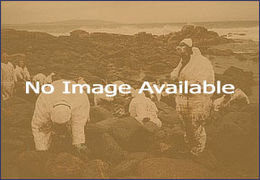
|
| 7 | Nowruz oil field
Oil spilled: 250,000 - 260,000 tonnes
In gallons: 77,000,000 - 80,080,000
In barrels: 1,832,500 - 1,905,800
Date: 4 Feb 1983 - May 1985
Location: Persian Gulf
Type: Oil well
Cause: War, tanker-platform collision
| A tanker collided with an oil platform in the Nowruz Oil Field, Iran on February 10th, 1983. The well began to leak approximately 1,500 barrels per day and could not be capped because of the ongoing Iran-Iraq war. In March the platform was attacked by Iraqi planes and the oil slick caught fire. Other platforms attacked began to leak an additional 5,000 barrels per day after the attacks.
In May 1985 the last of the fires were extinguished, and the wells could finally be plugged. Estimates for this spill on the internet vary between 733,000 and 4 million barrels.
References: [1] [2] | 
|
| 8 | Castillo de Bellver
Oil spilled: 254,000 tonnes
In gallons: 78,232,000
In barrels: 1,861,820
Date: 5 Aug 1983
Location: Saldanha Bay, South Africa
Type: Oil tanker
Cause: Caught fire, broke in two
| The Castillo de Bellver caught fire near Cape Town, South Africa on August 6th 1983. The ship broke in two during the fire and started drifting towards the shore - the stern section sank 24 miles off the coast, with perhaps 100,000 tonnes of oil remaining in the tanks. The bow section was towed further away from the coast and sunk using controlled explosives.
The spill had relatively little impact, considering the size of the spill. 1,500 oiled gannets were found on an island near the coast where they had been gathering for the onset of the breeding season. A black rain that fell on wheat fields and sheep grazing lands west of the explosion and fire in the days following the accident.
References: [1] | 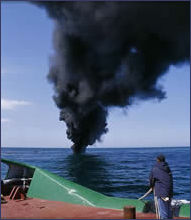
Thick black smoke from the Castillo de Bellver fire. (ITOPF) |
| 9 | Amoco Cadiz
Oil spilled: 223,000 - 229,000 tonnes
In gallons: 68,684,000 - 70,532,000
In barrels: 1,634,590 - 1,678,570
Date: 16 Mar 1978
Location: Portsall Rocks, Brittany, France
Type: Oil tanker
Cause: Ran aground in bad weather
| The Amoco Cadiz ran aground on March 16th, 1978 following a steering mechanism failure. The accident created a slick 30 by 130 kilometers (18 by 80 miles) long which polluted approximately 360 kilometers (220 miles) of Brittany coastline. Two weeks after the accident millions of dead molluscs, sea urchins and other species washed ashore. 20,000 dead birds were recorded.
The oil contaminated shoreline from Brest to Saint Brieuc, and even as far east as the Channel Islands.
References: [1] [2] [3] | 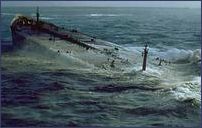
The Amoco Cadiz sinking. (NOAA) |
| 10 | ChevronTexaco Amazon oil spill
Oil spilled: 165,000 - 171,000 tonnes
In gallons: 50,820,000 - 52,668,000
In barrels: 1,209,450 - 1,253,430
Date: 1972 - June 1992
Location: Ecuadorian Amazon
Type: Drilling Operations
Cause: Waste product dumping
| In 1993 a number of Indian tribes from the Ecuadorian Amazon filed a lawsuit against Texaco for ruining their rivers and land, causing widespread devastation to the rainforest environment, and creating a dramatically increased risk of cancer for tens of thousands of people. The lawsuit states that Texaco dumped millions of gallons of waste oil products into the pristine rainforest river environment rather than re-inject it back into the well which is the industry practice in other parts of the world. Water and soil samples taken in the rainforest by toxicologists indicate life-threatening levels of Benzene, Toluene, Xylenes, and highly carcinogenic Polycyclic Aromatic Hydrocarbons.
Texaco extracted oil from the Ecuadorian Amazon from 1972 to 1992 at the rate of 220,000 to 250,000 barrels per day. An estimated 18.5 billion gallons of toxic waste water products were dumped into the river system or left in open, unlined pits during this time. While it is difficult to say exactly how many million gallons of crude oil this would correspond to, current estimates are at around three times the amount spilled in the Exxon Valdez disaster. The area that has been contaminated is roughly the size of the state of Rhode Island.
In June of 1992 Texaco withdrew from Ecuador, but many areas are still in need of cleanup operations and local peoples have still not been compensated. In some villages near polluted water sources, the rate of cancer is 1,000 times higher than the historical norm for the area, and hundreds of open-air leaking toxic waste pits still remain in the jungle without any cleanup performed.
In addition, 16.8 million gallons of crude oil has also been spilled directly from pipelines by ChevronTexaco's operations in the area.
This placemark marks the Sacha Sur area which was among the places reviewed during the lawsuit in March 2006. The Amazon Watch website has a video from the inspection (Spanish).
References: [1] [2] [3] [4] | 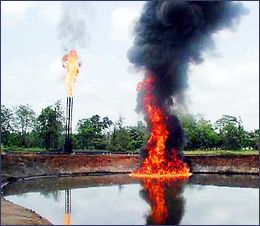
Texaco's Ecuador Operation. (Amazon Watch) |
| 11 | Haven
Oil spilled: 141,000 - 144,000 tonnes
In gallons: 43,428,000 - 44,352,000
In barrels: 1,033,530 - 1,055,520
Date: 11 Apr 1991
Location: Mediterranean Sea near Genoa, Italy
Type: Oil tanker
Cause: Caught fire while anchored, exploded
| The Haven tanker caught fire and exploded while anchored off Genoa, Italy on April 11, 1991. The ship split in three parts in the explosions, one part sank straight away and the remaining two sank during towing. Much of the oil was burned at sea but the slick still covered an estimated 12 by 4 kilometer (7.5 by 2.5 miles) three days after the spill. In the end close to 110 kilometers (70 miles) of coastline needed to be cleaned up, even though booms had been rapidly deployed to protect beaches from the slick. In some fishing areas a 43% reduction in fish populations could be noted after the spill.
References: [1] [2] | 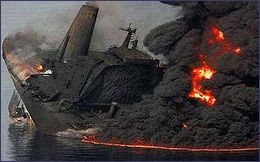
The Haven tanker on fire. (CTX) |
| 12 | Odyssey
Oil spilled: 132,000 tonnes
In gallons: 40,656,000
In barrels: 967,560
Date: 10 Nov 1988
Location: 700 nautical miles off Nova Scotia, Canada
Type: Oil tanker
Cause: Broke in two in bad weather
| The Odyssey tanker broke in two in heavy weather and caught fire before sinking on November 10th, 1988. There were no survivors among the 27 men crew.
References: [1] [2] | 
|
| 13 | Libya D-103 oil well
Oil spilled: 127,000 - 136,500 tonnes
In gallons: 39,116,000 - 42,042,000
In barrels: 930,910 - 1,000,545
Date: 1 Aug 1980 - 1981
Location: 800 km southeast of Tripoli, Libya
Type: Oil well
Cause: Blowout
| No information is available about this incident.
References: [2] [3] | 
|
| 14 | Torrey Canyon
Oil spilled: 119,000 - 122,000 tonnes
In gallons: 36,652,000 - 37,576,000
In barrels: 872,270 - 894,260
Date: 18 Mar 1967
Location: Scilly Isles, England
Type: Oil tanker
Cause: Navigation error, ran aground
| The Torrey Canyon was the first major supertanker disaster. Some 80 kilometers (50 miles) of French and 190 kilometers (120 miles) of Cornish coast were contaminated. Around 15,000 sea birds were killed, along with huge numbers of marine organisms, before the 700 square kilometers (270 square miles) slick dispersed. Much damage was also caused by the tens of thousands of toxic solvent-emulsifiers used to clean up the spill.
References: [1] [2] [3] | 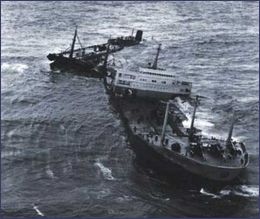
The Torrey Canyon after hitting Pollard's Rock on Seven Stones Reef off Lands End, England. |
| 15 | Sea Star
Oil spilled: 115,000 - 121,000 tonnes
In gallons: 35,420,000 - 37,268,000
In barrels: 842,950 - 886,930
Date: 19 Dec 1972
Location: Gulf of Oman
Type: Oil tanker
Cause: Ship collision
| The South Korean tanker Sea Star and the Brazilian tanker Horta Barbossa collided on the night of December 19th, 1972 in good visibility and light wind. The Horta Barbossa struck the Sea Star almost at right angles just forward of the bridge. Sea Star exploded and sank, killing 11 of her crew.
References: [1] [2] [3] | 
|
| 16 | Shuaiba Petroleum Tank
Oil spilled: 106,000 tonnes
In gallons: 32,648,000
In barrels: 776,980
Date: 20 Aug 1981
Location: Shuaiba, Kuwait
Type: Storage tank
Cause: Unknown
| No information is available about this incident.
References: [1] [2] | 
|
| 17 | Texaco Denmark
Oil spilled: 102,000 - 107,000 tonnes
In gallons: 31,416,000 - 32,956,000
In barrels: 747,660 - 784,310
Date: 7 Dec 1971
Location: Belgium; North Sea
Type: Oil tanker
Cause: Unknown
| No information is available about this incident.
References: [1] [2] | 
|
| 18 | Irenes Serenade
Oil spilled: 100,000 - 103,000 tonnes
In gallons: 30,800,000 - 31,724,000
In barrels: 733,000 - 754,990
Date: 23 Feb 1980
Location: Navarino Bay, Greece
Type: Oil tanker
Cause: Explosion while anchoring
| The Irenes Serenade burst into flames after an explosion occurred while anchoring off Pylos, Greece. The fire spread throughout ship which finally sank off Sfaktiria Island at 05:30 the next morning.
References: [1] [2] | 
|
| 19 | Usinsk Pipeline Spill
Oil spilled: 100,000 tonnes
In gallons: 30,800,000
In barrels: 733,000
Date: 25 Oct 1994
Location: Usinsk, Russia
Type: Pipeline
Cause: Leak, old equipment
| A pipeline 75 kilometers north of Usinsk in Russia began leaking in February 1994. Initially the leak was contained behind a dyke, though in October the same year heavy rains broke the dyke and thousands of tonnes of oil spilled into the Kolva River and out over the Arctic tundra.
Much of Russia's energy infrastructure is in bad condition, and the pipeline operated by Komineft which caused this leak was 20 years old. A limited cleanup was done, though large areas still remain polluted.
References: [1] [2] [3] | 
|
| 20 | Urquiola
Oil spilled: 96,000 - 101,000 tonnes
In gallons: 29,568,000 - 31,108,000
In barrels: 703,680 - 740,330
Date: 12 May 1976
Location: A Coruña, Spain
Type: Oil tanker
Cause: Ran aground
| The Urquiola oil tanker ran aground while approaching the Corunna Oil Terminal at A Coruña, Spain. The ship began to leak oil and later caught fire. Approximately 513,000 barrels, more than half of the oil onboard the ship, was burned during the 16 hour fire. A thick black cloud covered the town of A Coruña and spread over 100 kilometer inland.
Nearly 200 kilometer (125 miles) of coasts were affected. 70% of the clams, mussels and oysters the in Rio de Burgo bay were killed by the oil deposits.
References: [1] [2] [3] | 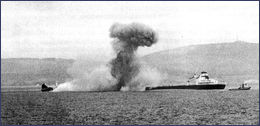
The Urquiola exploding. (CTX) |
| 21 | Hawaiian Patriot
Oil spilled: 95,000 - 101,000 tonnes
In gallons: 29,260,000 - 31,108,000
In barrels: 696,350 - 740,330
Date: 23 Feb 1977
Location: 300 nautical miles off Honolulu, Hawaii
Type: Oil tanker
Cause: Explosion, fire, broke in two
| The Hawaiian Patriot suffered hull damage in heavy weather on 23 Feb 1977. After exploding and catching fire it finally broke in two and sank on February 24.
References: [1] [2] | 
|
| 22 | Independenta
Oil spilled: 95,000 tonnes
In gallons: 29,260,000
In barrels: 696,350
Date: 15 Nov 1979 - 14 Dec 1979
Location: Bosphorus, Turkey
Type: Oil tanker
Cause: Ship collision, caught fire and ran aground
| The Independenta and the Evrialy collided on the morning of November 15th, 1979 at the southern entrance of the Bosphorus. The Independenta exploded and both vessels began to burn. The Independenta grounded a half of a mile from the port of Hydarpasa. The tanker burned for almost a month until December 14, 1979.
References: [1] [2] | 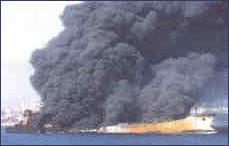
The Independenta burning. (CTX) |
| 23 | Pipeline 126
Oil spilled: 94,500 tonnes
In gallons: 29,106,000
In barrels: 692,685
Date: 25 May 1978
Location: Ahvaz, Iran
Type: Pipeline
Cause: Rupture
| No information is available about this incident.
References: [1] [2] | 
|
| 24 | Jakob Maersk
Oil spilled: 85,000 - 88,000 tonnes
In gallons: 26,180,000 - 27,104,000
In barrels: 623,050 - 645,040
Date: 29 Jan 1975
Location: Leixoes, Portugal
Type: Oil tanker
Cause: Ran aground while entering port
| The Jakob Maersk struck a sand bank while entering the port of Leixoes, Portugal. After explosions the ship burned for two days, consuming approximately half of the oil onboard, before it sank. Oil which later leaked from the sunken hull oiled 30 kilometers (19 miles) of the Portuguese coastline.
References: [1] [2] | 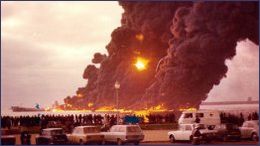
Fire on the Jakob Maersk. (CTX) |
| 25 | Braer
Oil spilled: 84,700 - 86,200 tonnes
In gallons: 26,087,600 - 26,549,600
In barrels: 620,851 - 631,846
Date: 5 Jan 1993
Location: Shetland Islands, UK
Type: Oil tanker
Cause: Engine failure, ran aground in bad weather
| The Braer ran aground west of Sumburgh Head, Shetland Islands on January 5th, 1993 following engine failure. The wind was too strong to mount a recovery operation, and over the next twelve days the waves broke the ship apart, spilling the 85,000 tonnes of crude oil onboard.
While seabird casualties were relatively low fish and shellfish over a large area became contaminated with oil and a Fisheries Exclusion Zone had to be set up. Millions of farmed salmon in sea cages could not be sold and had to be destroyed. Mussels and lobsters could still not be harvested 6 years later.
References: [1] [2] | 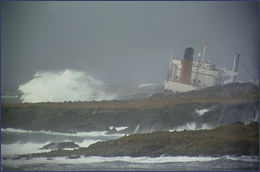
The Braer after running aground. (Wikipedia) |
| 26 | Shell Storage Tank #6
Oil spilled: 77,600 - 79,000 tonnes
In gallons: 23,900,800 - 24,332,000
In barrels: 568,808 - 579,070
Date: 6 Jul 1979
Location: Forcados, Nigeria
Type: Storage tank
Cause: Leak
| Hundreds of pipeline leaks and other oil spills happen every year in the Nigerian delta. The biggest single incident to date occurred at the Shell Forcados terminal in 1979 when 580,000 barrels of oil leaked into the delta, damaging vast areas of mangrove forest and rivers.
References: [1] [2] [3] | 
|
| 27 | Newtown Creek Oil Spill
Oil spilled: 55,000 - 97,000 tonnes
In gallons: 16,940,000 - 29,876,000
In barrels: 403,150 - 711,010
Date: 15 Nov 1979 - 14 Dec 1979
Location: Newtown Creek, Greenpoint, Brooklyn, New York
Type: Oil refinery
Cause: 1950 tank explosion
| A 1950 tank explosion and other leaks during the 1940's and 50's spread millions of gallons of oil through the ground across 55 acres of Greenpoint, which at the time was home to a number of major oil refineries. The leak went unnoticed until 1978 when the Coast Guard noticed an oil plume from helicopter. This led to the discovery of an huge pool of oil at the creek's bottom.
Petroleum from the spill is still leaking into Newtown Creek; globs of oil and a rainbow sheen can be seen on this small waterway separating Brooklyn and Queens.
The oil companies in charge of the refineries, ExxonMobil, ChevronTexaco, BP and others, are currently being sued by the residents of the area.
References: [1] [2] [3] | 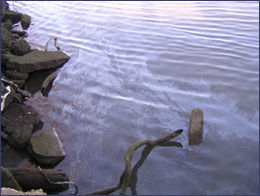
Oil in Newtown Creek. (Riverkeeper) |
| 28 | Katina P
Oil spilled: 72,600 tonnes
In gallons: 22,360,800
In barrels: 532,158
Date: 16 Apr 1992
Location: Maputo, Mozambique
Type: Oil tanker
Cause: Storm damage
| The Katina P tanker was damaged in a storm and had to be deliberately beached close to Maputo Bay on April 18, 1992. Four days later it was towed out to sea and sank in deep water.
References: [1] [2] [3] | 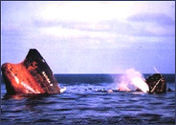
The Katina P tanker sinking. (CTX) |
| 29 | Sea Empress
Oil spilled: 72,400 tonnes
In gallons: 22,299,200
In barrels: 530,692
Date: 15 Feb 1996
Location: Milford Haven Bay, Wales
Type: Oil tanker
Cause: Ran aground
| The Sea Empress ran aground on the evening of February 15th, 1996 in bad weather. Between the 23rd of February and 4th of March 58,200 tonnes of crude oil was recovered from the ship, but an even bigger amount was spilled into the ocean. 200 kilometers (125 miles) of coastline - much of it in a National Park - was contaminated and several thousand oiled birds washed ashore. A major cleanup effort was mounted, involving mechanical recovery, trenching, beach washing, and the use of dispersants and sorbents.
References: [1] [2] | 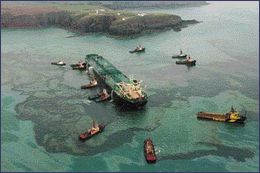
Sea Empress after running aground at Saint Ann's Head at the entrance to Milford Haven Bay. |
| 30 | Khark 5
Oil spilled: 62,000 - 80,000 tonnes
In gallons: 19,096,000 - 24,640,000
In barrels: 454,460 - 586,400
Date: 19 Dec 1989
Location: 400 miles north of the Canary Islands
Type: Oil tanker
Cause: Fire, explosion
| The Iranian oil tanker Khark 5 exploded and caught fire during a storm off the coast of Safi, 400 miles north of the Canary Islands on December 19, 1989. Roughly a quarter of the vessel's cargo of 250,000 tonnes was spilled through a 20 by 30 meter hole in the ships side, but it appears that little or no oil ever reached the coast.
References: [1] [2] [3] | 
|
| 31 | Aegean Sea
Oil spilled: 67,000 - 74,600 tonnes
In gallons: 20,636,000 - 22,976,800
In barrels: 491,110 - 546,818
Date: 3 Dec 1992
Location: A Coruña, Spain
Type: Oil tanker
Cause: Ran aground in bad weather, caught fire
| The Aegean Sea spill affected more than 300 kilometers (180 miles) of shoreline, in the same area hit just a decade earlier by the Urquiola spill. The fishing industry was badly hit by this spill which affected more than 4,000 fishermen, shellfish harvesters and fish farmers. A ban was put in place on fishing and on the sale of all seafood from the area until September 1993.
References: [1] [2] | 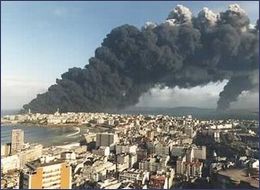
The fire from the Aegean Sea aground by Torre de Hercules near the entrance to La Coruña harbour. |
| 32 | Nova
Oil spilled: 68,000 - 73,000 tonnes
In gallons: 20,944,000 - 22,484,000
In barrels: 498,440 - 535,090
Date: 6 Dec 1985
Location: 140km south of Kharg Island, Gulf of Iran
Type: Oil tanker
Cause: Ship collision
| Very little information is available about this incident. It appears the tanker Nova collided with a ship called Magnum south of Kharg Island, Iran.
References: [1] [2] | 
|
| 33 | Prestige
Oil spilled: 63,000 - 77,000 tonnes
In gallons: 19,404,000 - 23,716,000
In barrels: 461,790 - 564,410
Date: 13 Nov 2002 - 19 Nov 2002
Location: Bay of Biscay, Galicia, Spain (170 miles west of Vigo)
Type: Oil tanker
Cause: Heavy seas
| After suffering hull damage in heavy seas the Prestige tanker was towed to, but denied port in either Spain or Portugal. Towed back into the Atlantic the ship broke in two and sank in water two miles deep a week later on November 19th, 2002. Oil first came ashore in Galicia, then the Bay of Biscay and affecting the north coast of Spain and the Atlantic coast of France as far north as Brittany. Light contamination was found as far away as the French and English coasts of the English Channel. Altogether approximately 1,900 kilometer (1,200 miles) of shoreline was affected. WWF estimates the total number of birds affected during the first two months of the Prestige oil spill to be between 65,000 and 130,000. The most affected species were Guillemot (5,691 live and dead), Razorbill (2,248 live and dead) and Puffin (1,877 live and dead).
References: [1] [2] [3] [4] | 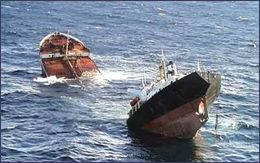
The Prestige tanker breaking in two. |
| 34 | Yuyo Maru 10
Oil spilled: 68,000 tonnes
In gallons: 20,944,000
In barrels: 498,440
Date: 9 Nov 1974
Location: Tokyo Bay
Type: Oil tanker
Cause: Ship collision
| The Yuyo Maru 10 tanker collided with the ship Pacific Ares in the Uraga Channel in Tokyo Bay. 34 men were killed in the accident after the ship caught fire. All efforts to extinguish the fires failed and finally after 19 days the ship, still burning, was towed far out to sea and sunk by torpedo and gunfire.
References: [2] | 
|
| 35 | Sinclair Petrolore
Oil spilled: 51,000 - 59,000 tonnes
In gallons: 15,708,000 - 18,172,000
In barrels: 373,830 - 432,470
Date: 6 Dec 1960
Location: Brazil
Type: Oil tanker
Cause: Unknown
| No information is available about this incident.
References: [1] [2] | 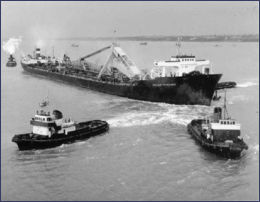
The Sinclair Petrolore (CTX) |
| 36 | Assimi
Oil spilled: 51,600 tonnes
In gallons: 15,892,800
In barrels: 378,228
Date: 7 Jan 1983
Location: Gulf of Oman
Type: Oil tanker
Cause: Fire, explosion
| A fire broke out in the engine room of the tanker Assimi on January 7th, 1983. Three days later explosions took place and the fire intensified. The Assimi finally sunk on January 16, after being towed to deep water 200 miles from the Oman coast. Further explosion occurred as the vessel split in two and sank which ignited the oil on the surface of the water.
Thanks to the vessel having been towed out to sea there was no coastal pollution resulting from the incident.
References: [1] [2] | 
|
| 37 | Metula
Oil spilled: 50,000 - 53,000 tonnes
In gallons: 15,400,000 - 16,324,000
In barrels: 366,500 - 388,490
Date: 9 Aug 1974
Location: Eastern Strait of Magellan, Chile
Type: Oil tanker
Cause: Ran aground
| The Metula spill affected the shores and saltmarshes of northern Tierra del Fuego. About 4,000 birds are known to have been killed, including cormorants and penguins. No cleanup was done because of the remoteness of the area, and many areas were still contaminated 20 years after the spill.
References: [1] [2] | 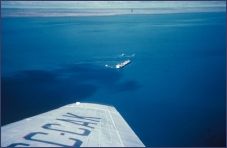
The Metula seen from the air. (ITOPF) |
| 38 | Andros Patria
Oil spilled: 50,000 tonnes
In gallons: 15,400,000
In barrels: 366,500
Date: 31 Dec 1978
Location: Bay of Biscay, France
Type: Oil tanker
Cause: Fire, explosion
| The Andros Patria was loaded with 208,000 tonnes of crude oil when she developed a 50 feet crack in the hull on New Year's Eve, 1978. Within two hours a fire broke out and oil started washing out into the sea. 30 of the 33 men onboard abandoned ship on a lifeboat which capsized throwing its occupants into the sea. Only the three men remaining onboard survived as they could be rescued by helicopter the following day.
The rough seas and cleanup effort using large quantities of detergent meant only a small amount of pollution from the oil slick was observed on the coast.
References: [1] [2] | 
|
| 39 | Ennerdale
Oil spilled: 44,800 - 47,000 tonnes
In gallons: 13,798,400 - 14,476,000
In barrels: 328,384 - 344,510
Date: 1 Jun 1970
Location: Seychelles
Type: Oil tanker
Cause: Grounding
| The Ennerdale grounded on an unmarked rock in the Seychelles on June 1st 1970. About 45,000 tonnes of oil were spilled. The area has recovered enough that the wreck is now a dive site - the reef she hit has been named Ennerdale Rocks.
References: [1] | 
|
| 40 | World Glory
Oil spilled: 45,500 tonnes
In gallons: 14,014,000
In barrels: 333,515
Date: 13 Jun 1968
Location: South Africa
Type: Oil tanker
Cause: Broke up in bad weather
| The World Glory tanker broke in two close to Durban, South Africa in gale force winds and poor visibility. 24 crew members were lost. The stern section of the vessel sank after two hours, while the bow section drifted 40 miles southwest before it too sank.
A 95 kilometers (60 miles) long oil slick came within two miles of the South Africa coast and close to the St. Lucia Game Reserve but the $420,000 cleanup operation appears to have succeeded in avoiding the worst of the effects.
References: [1] [2] | 
|
| 41 | Pericles GC
Oil spilled: 39,000 - 47,000 tonnes
In gallons: 12,012,000 - 14,476,000
In barrels: 285,870 - 344,510
Date: 9 Dec 1983
Location: Persian/Arabian Gulf
Type: Oil tanker
Cause: Fire, explosions, sank
| A fire broke out in the engine room of the Pericles GC about 200 miles off Doha in Qatar. The crew abandoned the ship which sank after explosions and came to rest on the sea bed with 30 feet of the hull visible above water.
References: [1] | 
|
| 42 | Funiwa No. 5 Well
Oil spilled: 27,000 - 57,400 tonnes
In gallons: 8,316,000 - 17,679,200
In barrels: 197,910 - 420,742
Date: 17 Jan 1980 - 1 Feb 1980
Location: Niger Delta, Nigeria
Type: Oil well
Cause: Blowout
| Tecaxo's Funiwa 5 well suffered a blowout on January 17th 1980. The well (also known as North Apoi 20) leaked an estimated 146,000 - 421,000 barrels of oil before it caught fire on January 30th.
The leak polluted large areas of mangrove forests, estuaries, lagoons, lakes and rivers and rendered the usual sources of drinking water in the area unsafe. A total of about 223,000 people were affected by the spill and 180 persons in Sangana died in March 1980 as a result of factors related to the pollution. Over 300 fishing ports were impacted and many sea foods were killed or tainted.
References: [1] [2] [3] | 
|
| 43 | Mandoil II
Oil spilled: 40,000 - 43,300 tonnes
In gallons: 12,320,000 - 13,336,400
In barrels: 293,200 - 317,389
Date: 28 Feb 1968
Location: 550km west of Oregon
Type: Oil tanker
Cause: Ship collision
| The Mandoil II tanker collided with the Suwaharu Maru in dense fog on February 28, 1968. The Mandoil II caught fire and had to be abandoned. Roughly 40,000 tonnes of oil was spilled into the ocean.
References: [1] | 
|
| 44 | British Ambassador
Oil spilled: 40,000 tonnes
In gallons: 12,320,000
In barrels: 293,200
Date: 10 Jan 1975
Location: North Pacific
Type: Oil tanker
Cause: Engine room leak
| The British Ambassador suffered an engine room leak (caused by a shattered cooling pipe) on the 10th of January 1975. The ship sank in high winds while under tow, and roughly 40,000 tonnes of oil was leaked into the ocean.
References: [1] | 
|
| 45 | Betelgeuse
Oil spilled: 40,000 tonnes
In gallons: 12,320,000
In barrels: 293,200
Date: 8 Jan 1979
Location: Bantry Bay, Ireland
Type: Oil tanker
Cause: Explosion while unloading
| The Betelgeuse oil tanker was unloading her cargo at the Gulf Oil Terminal on Whiddy Island when the vessel exploded, still containing 40,000 tonnes of oil. 50 of the crew members were killed and the Betelgeuse was split in two during the explosion. Both parts of the ship sank spilling the 40,000 tonnes of remaining cargo.
Most of the oil was prevented from reaching the shoreline by a large cleanup operation using booms, skimmers and dispersants sprayed from planes. Oiled seabirds were found and the pollution affected the fishing and shellfish industries.
References: [1] [2] [3] | 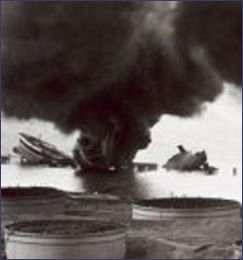
Betelgeuse on 8 January 1979. (Wikipedia) |
| 46 | Tadotsu
Oil spilled: 40,000 tonnes
In gallons: 12,320,000
In barrels: 293,200
Date: 7 Dec 1978
Location: Near Dumai, Sumatra
Type: Oil tanker
Cause: Unknown
| No information is available about this incident.
References: [1] | 
|
| 47 | St. Peter
Oil spilled: 38,000 tonnes
In gallons: 11,704,000
In barrels: 278,540
Date: 4 Feb 1976
Location: 30 miles west of Cabo Mangalares, Colombia
Type: Oil tanker
Cause: Fire, sank
| A fire broke out in the engine room of the St. Peter tanker on February 4th, 1976. The vessel burned for two or three days before it sank approximately 18 miles off Cabo Manglares, Colombia. The wreck lying at a depth of 1000 meters was known to be leaking oil nine months after sinking. 320 kilometers (200 miles) of shorelines, beaches and mangroves were affected by the spill, from Buenaventura, Colombia in the north to Punta Galera, Ecuador in the south. Worst affected were the areas of Tumaco, Colombia and shorelines further south, near the Ecuador border.
References: [1] | 
|
| 48 | Exxon Valdez
Oil spilled: 37,000 - 38,800 tonnes
In gallons: 11,396,000 - 11,950,400
In barrels: 271,210 - 284,404
Date: 24 Mar 1989
Location: Bligh Reef in Prince William Sound, Alaska
Type: Oil tanker
Cause: Ran aground
| Exxon Valdez was the largest tanker spill in US history. Oil from the spill affected shorelines over an estimated 1,800-2,100 kilometer (1,100-1,300 miles) in Prince William Sound and along Alaska's south coast as far west as Kodiak Island. About 1,000 sea otters are known to have died, and over 35,000 dead birds were retrieved. Cleanup efforts included high pressure hot water washing of beeches, booming of salmon hatcheries to protect fisheries and bioremediation techniques. Tens of thousands of people were involved, as well as 1,400 ships and 85 helicopters.
WWF estimates for full number of animals killed by the spill are: 250,000 seabirds, 2,800 sea otters, 300 harbor seals, 250 bald eagles, 22 killer whales.
Some beaches still remain oiled today.
References: [1] [2] [3] [4] | 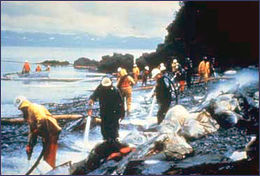
The cleanup after the Exxon Valdez disaster cost over US$2 billion in the first year alone. (NOAA) |
| 49 | Juan Lavalleja
Oil spilled: 28,000 - 45,200 tonnes
In gallons: 8,624,000 - 13,921,600
In barrels: 205,240 - 331,316
Date: 28 Dec 1980
Location: Arzew, Algeria
Type: Oil tanker
Cause: Grounding, unmoored during storm
| No information is available about this incident.
References: [1] | 
|
| 50 | Corinthos
Oil spilled: 35,700 - 36,200 tonnes
In gallons: 10,995,600 - 11,149,600
In barrels: 261,681 - 265,346
Date: 31 Jan 1975
Location: Delaware River, Marcus Hook, Pennsylvania
Type: Oil tanker
Cause: Ship collision
| The Corinthos was accidentally rammed by the Edgar M. Queeny shortly after midnight on January 31, 1975. The ship had been in the process of offloading 315,000 barrels of crude oil at the BP terminal at Marcus Hook in Pennsylvania. 26 of the crew died in the fire and explosions that resulted, and most of the oil cargo was spilled into the Delaware River.
References: [1] [2] | 
|
| 51 | Thanassis A
Oil spilled: 35,400 tonnes
In gallons: 10,903,200
In barrels: 259,482
Date: 21 Oct 1994
Location: South China Sea
Type: Oil tanker
Cause: Broke in two in bad weather
| The Thanassis A broke in two in the typhoon Teresa on October 21st, 1994. Over 35,000 tonnes of heavy fuel oil was spilled.
References: [1] | 
|
| 52 | Napier
Oil spilled: 35,300 tonnes
In gallons: 10,872,400
In barrels: 258,749
Date: 10 Jun 1973
Location: Guamblin Island, Chile
Type: Oil tanker
Cause: Ran aground
| The Napier ran aground fully loaded with crude oil on June 10th, 1973 near Guamblin Island, Chile. The crew was rescued and the Chilean air force set the ship and cargo on fire.
References: [1] | 
|
| 53 | Athenian Venture
Oil spilled: 34,300 tonnes
In gallons: 10,564,400
In barrels: 251,419
Date: 22 Apr 1988
Location: 600km off Cape Race, Newfoundland
Type: Oil tanker
Cause: Explosion, broke in two
| The cause for the explosion on the Athenian Venture is not known. When the ship was found in April 1988 the bow and aft sections were on fire and already drifting two miles apart from each other. All of the 29 people on board were presumed dead after the search for survivors returned nothing. The bow section sank on April 22 while the aft section continued to be on fire and drift for the next seven weeks. It finally sunk on June 17 about 200 miles from the Azores.
An oil slick 4 miles long was seen on the sea surface, but most of the gasoline and oil onboard the tanker burned in the extensive fires.
References: [1] | 
|
| 54 | Wafra
Oil spilled: 27,000 - 40,000 tonnes
In gallons: 8,316,000 - 12,320,000
In barrels: 197,910 - 293,200
Date: 27 Feb 1971
Location: South Africa
Type: Oil tanker
Cause: Ran aground while towed
| The tanker Wafra was towed off Cape Alghulas, South Africa after the engine room had flooded. When the towline broke Wafra drifted onto the Agulhas Reef, five miles from Cape Agulhas. It was towed off the reef and sunk 200 miles from the coast on March 12.
References: [1] [2] | 
|
| 55 | Occidental Petroleum Peru Block 1AB
Oil spilled: 30,000 tonnes
In gallons: 9,240,000
In barrels: 219,900
Date: 1975 - present
Location: Peruvian Amazon
Type: Drilling Operations
Cause: Waste product dumping
| The American company Occidental Petroleum signed contract for oil drilling in Block 1AB in the Peruvian Amazon in 1971. Major drilling operations in the half-million hectare area started in 1975. In a similar situation to the Texaco Ecuador operation, poor standards no longer legal in most countries were used - including the dumping of waste oil products into the pristine rainforest river environment instead of re-injecting back underground. An estimated 9 billion barrels of toxic waste water products were dumped during the 30 years of operation by Occidental - an average of 850,000 barrels per day.
The area which Block 1AB occupies is an indigenous territory, home to the Achuar people for thousands of years. Many children and adults in the Achuar communities downstream of the drilling operations now have dangerously high levels of lead and cadmium in their blood, and are suffering other ill effects of the petroleum extraction activities. Fish and game which the Achuar communities depend on has also declined due to the extensive pollution in the area. In 1984 the Peruvian government named Block 1-AB 'the country's most damaged environmental region'.
In 2000 Occidental Petroleum sold the rights for Block 1AB to Pluspetrol, an Argentinean company. Pluspetrol has continued to use the substandard infrastructure and production methods left behind by Occidental, and the contamination of the Achuar land continues today.
In 2007 the Achuar communities filed a lawsuit in the US against Occidental Petroleum for polluting their rivers and drinking water with carcinogenic hydrocarbon compounds and heavy metals like lead, cadmium, mercury, arsenic. Ill effects experienced by the Achuar include an increased risk of cancer, and lead poisoning is widespread among Achuar children. The Achuar is currently waiting to hear if the case will be accepted in US courts.
The Peruvian government is currently opening up a number of new areas to oil company bidding - in the last few years the proportion of the Peruvian Amazon zoned into hydrocarbon blocks has increased from 13% to 70%. Several of the new proposed blocks overlap indigenous territories, natural protected areas, or reserves for indigenous peoples who live in voluntary isolation.
References: [1] [2] [3] [4] | 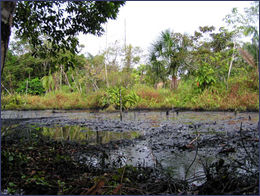
Contaminated area in the Peruvian Amazon (Amazon Watch) |
| 56 | Tasman Spirit
Oil spilled: 27,000 - 30,000 tonnes
In gallons: 8,316,000 - 9,240,000
In barrels: 197,910 - 219,900
Date: 28 Jul 2003
Location: Karachi Port, Pakistan
Type: Oil tanker
Cause: Ran aground at port entrance
| On July 27th, 2003 the Tasman Spirit grounded at the entrance to Karachi Port, Pakistan carrying 67,800 tonnes of light crude oil. By August 11th roughly half of the cargo had been transferred to other ships and three days later the Tasman Spirit finally broke in two, after attempts had been made to tow it. Thousands of tonnes of the remaining cargo was spilled.
Much of the oil stranded on a 14 kilometer stretch of the Clifton Beach, the main tourist beach in Karachi, but significant quantities remained afloat both inside and outside Karachi port. The spill endangered green turtle nesting grounds and posed a threat to migratory birds and marine life. Dead fish and finless porpoise were found on the beaches.
Clifton Beach could finally be re-opened to the public in October 2003.
References: [1] [2] [3] | 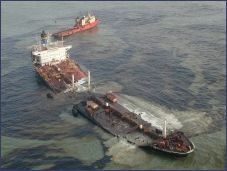
The Tasman Spirit. (CTX) |
| 57 | Evoikos
Oil spilled: 25,000 - 29,000 tonnes
In gallons: 7,700,000 - 8,932,000
In barrels: 183,250 - 212,570
Date: 15 Oct 1997
Location: Singapore Strait
Type: Oil tanker
Cause: Ship collision
| The two tankers Evoikos and Orapin Global collided in the Singapore Strait on the evening of October 15, 1997. The Orapin Global (going west) was moving in the buffer zone between the eastbound and westbound lanes where it had been overtaking a smaller vessel, while the Evoikos (going east) was crossing the westbound lane to enter the harbour. The collision ripped a hole 50 meters long and 10 meters high in the Evoikos, opening three tanks and spilling over 25,000 tonnes of oil into the strait. Dozens of islands near the strait were contaminated, as well as parts of the Malaysian shoreline further north. The cleanup lasted for three weeks and cost 7.5 million USD.
References: [1] [2] | 
The Evoikos anchored after the collision. |
| 58 | Argo Merchant
Oil spilled: 25,000 - 28,000 tonnes
In gallons: 7,700,000 - 8,624,000
In barrels: 183,250 - 205,240
Date: 15 Dec 1976 - 22 Dec 1976
Location: Southeast of Nantucket Island, Massachusetts
Type: Oil tanker
Cause: Ran aground in bad weather
| The Liberian tanker Argo Merchant went aground in high winds and ten foot seas on December 15th, 1976 on Fishing Rip (Nantucket Shoals) 29 nautical miles southeast of Nantucket Island, Massachusetts. The captain requested permission to dump the cargo in an effort to re-float the ship, but did not receive permission. The next day the crew was evacuated and on December 21 the vessel broke in two and started leaking its cargo. The bow section capsized on December 22, spilling the remaining oil before it was sunk by the coast guard. The stern section remained aground. Thankfully most of the oil was carried away from the shoreline by the ocean currents.
References: [1] [2] | 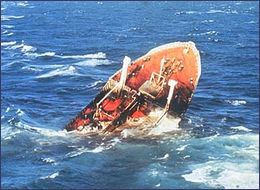
The Argo Merchant sinking. (NOAA) |
| 59 | Texaco Oklahoma
Oil spilled: 25,700 tonnes
In gallons: 7,915,600
In barrels: 188,381
Date: 27 Mar 1971
Location: 120 miles north-east of Hatteras
Type: Oil tanker
Cause: Broke in two in bad weather
| The Texaco Oklahoma broke apart in gale force winds and 30-40 foot seas on the afternoon of March 27, 1971. Only 13 of the 44 crew members survived.
References: [1] | 
|
| 60 | Jiyyeh Power Station
Oil spilled: 20,000 - 30,000 tonnes
In gallons: 6,160,000 - 9,240,000
In barrels: 146,600 - 219,900
Date: 13 Jul 2006 - 15 Jul 2006
Location: Lebanon
Type: Power plant
Cause: War
| The Israeli army bombed the Jiyyeh power station in Lebanon between July 13 and 15 2006, during the Second Lebanon War / July War. This led to the biggest oil spill in Lebanese history, and one of the worst ever in the Mediterranean Sea. A cleanup effort could not be mounted until the hostilities between the two countries had ended in August, by which time the oil already covered 120 kilometers (75 miles) of coast line.
Is is estimated that the Lebanese fishing industry will suffer for several years after the spill, and it might take 10 years for the environment to fully recover. The tourism industry was also hit, and environmental organizations expressed fears for the green turtle population, as the turtle eggs usually hatch on the Lebanese beaches during the month of July.
References: [1] [2] [3] [4] | 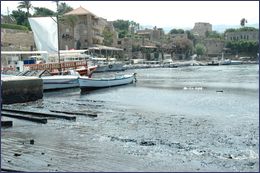
Oil slick in the harbour of Byblos. (Wikipedia) |
| 61 | Erika
Oil spilled: 19,000 - 28,000 tonnes
In gallons: 5,852,000 - 8,624,000
In barrels: 139,270 - 205,240
Date: 12 Dec 1999
Location: Bay of Biscay, France
Type: Oil tanker
Cause: Broke in two in bad weather
| The Erika tanker started breaking in two 60 miles from the coast of Brittany in bad weather on December 11th, 1999. The bow sank a small distance away from where the ship had broken up, and the stern sank the following day 10 kilometer away. Intermittent oiling occurred over some 400 kilometers (250 miles) of shoreline between Finistère and Charente-Maritime. Almost 65,000 oiled birds were collected from beaches, of which almost 50,000 were dead. A major cleaning operation was mounted for the 15,000 oiled survivors and 2,000 were ultimately released.
More than 250,000 tonnes of oily waste was collected from beaches during the cleanup operation.
Following the Erika disaster the EU introduced tougher safety standards, including the banning of single-hulled vessels such as this ship.
References: [1] [2] [3] | 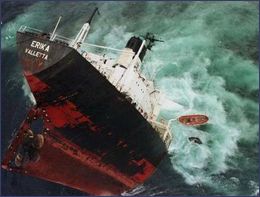
The Erika sinking after splitting in two. |
| 62 | Burmah Agate
Oil spilled: 8,440 - 34,700 tonnes
In gallons: 2,599,520 - 10,687,600
In barrels: 61,865 - 254,351
Date: 1 Nov 1979 - 8 Jan 1980
Location: Galveston Bay, Texas
Type: Oil tanker
Cause: Ship collision, fire
| The Burmah Agate tanker collided with the ship Mimosa at the entrance to Galveston Harbor on November 1st, 1979. Several of the crew members on the Burmah Agate died in the fire and explosions that resulted, and the ship burned for over 9 weeks. On February 1st, 1980 it could finally be towed away for scrapping.
Much of the crude oil onboard the tanker burned, but many thousand tonnes also made it into the environment and an oil slick 30 kilometers (19 miles) long covered the sea surface. Hundreds of people were involved in the cleanup of the beaches of the area after the spill, which polluted over 250 kilometers (160 miles) of the Texas coast.
References: [1] [2] | 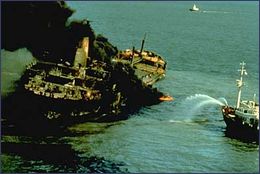
The Burmah Agate burning. (NOAA) |
| 63 | Ekofisk Bravo oil field
Oil spilled: 15,000 - 27,600 tonnes
In gallons: 4,620,000 - 8,500,800
In barrels: 109,950 - 202,308
Date: 22 Apr 1977
Location: North Sea
Type: Oil well
Cause: Blowout
| On April 22nd, 1977 an oil and natural gas blowout occurred at well B-14 on the Bravo production platform in the Norwegian Ekofisk field. A red-brown mixture composed of oil and mud spurted up to 180 feet into the air above the offshore drilling rig. The 'blowout preventer' in place on the well had apparently been installed upside down! An estimated 1170 barrels per hour escaped before the well could finally be capped seven days later.
References: [1] [2] | 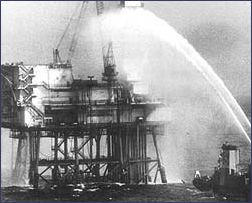
The Ekofisk Bravo platform during the blowout. |
| 64 | Nakhodka
Oil spilled: 17,000 - 19,000 tonnes
In gallons: 5,236,000 - 5,852,000
In barrels: 124,610 - 139,270
Date: 2 Jan 1997
Location: Sea of Japan
Type: Oil tanker
Cause: Broke in two in bad weather
| The tanker Nakhodka capsized and broke in two during a storm on January 2nd, 1997 on the west side of the Japanese island of Honshu. The bow section eventually ran aground on the coast while the stern section sank with some of its cargo still onboard 120 miles from the coast. Over 300 kilometer (180 miles) of Japanese coast was affected, making this the worst oil spill in Japanese history.
References: [1] [2] | 
|
| 65 | Tanio
Oil spilled: 13,500 - 21,000 tonnes
In gallons: 4,158,000 - 6,468,000
In barrels: 98,955 - 153,930
Date: 7 Mar 1980
Location: Brittany, France
Type: Oil tanker
Cause: Broke in two in bad weather
| The Tanio broke in two during a violent storm off the coast of Brittany, France on March 7th, 1980. The spilled oil started to wash ashore on March 9th, and eventually contaminated about 200 kilometer of coastline to varying degrees.
References: [1] [2] [3] | 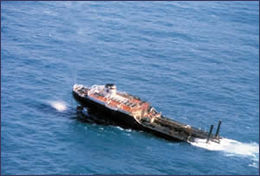
The stern of the Tanio. (Cedre.fr) |
| 66 | Montara
Oil spilled: 4,000 - 30,000 tonnes
In gallons: 1,232,000 - 9,240,000
In barrels: 29,320 - 219,900
Date: 21 Aug 2009 - 3 Nov 2009
Location: Timor Sea
Type: Oil well
Cause: Well head leak
| The West Atlas oil rig in the Timor Sea began leaking in late August 2009, releasing up to 2,000 barrels of oil into the water per day. Four initial attempts to seal the well failed, and it continued to leak for a full 10 weeks, making this the worst oil spill in Australian history. At most the spill measured over 85 kilometers on the surface, endangering many migrating species like loggerhead turtles, dolphins, and whales.
References: [1] [2] [3] | 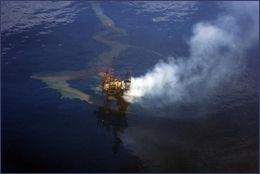
The damaged West Atlas oil rig. (Wikipedia) |
| 67 | Gunvor Maersk
Oil spilled: 16,000 - 17,000 tonnes
In gallons: 4,928,000 - 5,236,000
In barrels: 117,280 - 124,610
Date: 27 Oct 1979
Location: Manaus, Brazil
Type: Oil tanker
Cause: Grounded, fire
| The Gunvor Maersk caught fire and suffered explosions after striking a submerged object near Manaus in the Brazilian Amazon on October 27, 1979. The ship burned for eight days and an estimated 16,000 tonnes of diesel oil, gasoline, and kerosense was spilled into the Amazon river system.
References: [1] [2] | 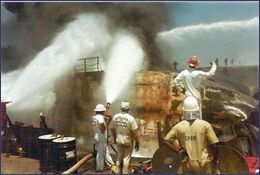
Trying to put out the Gunvor Maersk fire. (Agner Marine Consult) |
| 68 | Seki and Baynuna
Oil spilled: 15,260 - 16,000 tonnes
In gallons: 4,700,080 - 4,928,000
In barrels: 111,856 - 117,280
Date: 31 Mar 1994
Location: Gulf of Oman, near Fujaira
Type: Oil tanker
Cause: Collision
| The tankers Seki and Baynuna collided in the Gulf of Oman in March 1994, resulting in the Seki spilling 16,000 tons of Iranian light crude oil into the sea. 30 kilometers of coastline was oiled and dead fish and turtles were found washing up on the beaches.
References: [1] [2] | 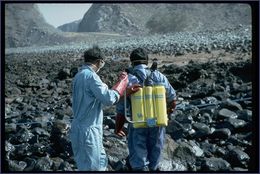
Workers cleaning a beach after the Seki and Baynuna incident. NOAA |
| 69 | Megaborg
Oil spilled: 13,600 - 16,500 tonnes
In gallons: 4,188,800 - 5,082,000
In barrels: 99,688 - 120,945
Date: 8 Jun 1990
Location: Gulf of Mexico, southeast of Galveston, Texas
Type: Oil tanker
Cause: Ship collision
| The Megaborg suffered an explosion and caught fire while transferring oil cargo to the tank vessel Fraqmura 57 miles off Galveston, Texas.
References: [1] | 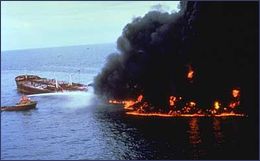
The Megaborg burning. (NOAA) |
| 70 | Santa Barbara oil spill
Oil spilled: 11,000 - 13,600 tonnes
In gallons: 3,388,000 - 4,188,800
In barrels: 80,630 - 99,688
Date: 28 Jan 1969 - 7 Feb 1969
Location: Santa Barbara Channel, California
Type: Oil Well
Cause: Blowout
| Union Oil's Platform A suffered a blowout in January 1969, resulting in 80,000 to 100,000 barrels of crude oil spilling into the Santa Barbara Channel. Miles of Southern California beaches were oiled, killing seals, dolphins and thousands of birds.
"I don't like to call it a disaster, because there has been no loss of human life: I am amazed at the publicity for loss of a few birds"
Fred Hartley, president of Union Oil in 1969.
The disaster helped kick-start the US environmental movement and create stricter regulations regarding off-shore drilling.
References: [1] [2] [3] | 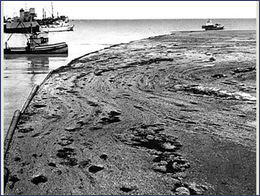
The Santa Barbara Oil Spill |
| 71 | Hebei Spirit
Oil spilled: 9,000 - 10,800 tonnes
In gallons: 2,772,000 - 3,326,400
In barrels: 65,970 - 79,164
Date: 8 Dec 2007
Location: 10 km off the coast of South Korea, west of Taean county
Type: Oil tanker
Cause: Ship collision
| The oil slicks from the Hebei Spirit spill impacted between 160 and 300 kilometer (100 - 160 miles) of coastline. The heaviest concentrations of oil were found in Teaen county and points 30 miles to the north. About 9000 people and 140 ships were involved in cleaning up the beaches and preventing more oil from washing ashore.
The seafood industry in the area, oyster beds and seafood farms, were devastated by the spill. The area is also home to large wetlands which are very important for migratory birds.
References: [1] [2] [3] [4] | 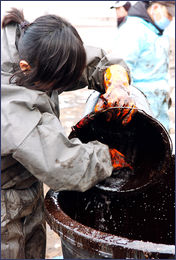
A volunteer collecting oil from the beach after the Hebei Spirit spill. (Wikipedia) |
| 72 | M/V Alvenus
Oil spilled: 8,930 tonnes
In gallons: 2,750,440
In barrels: 65,457
Date: 30 Jul 1984
Location: Cameron, Louisiana
Type: Oil tanker
Cause: Grounded
| The tanker Alvenus grounded in the Calcasieu River Bar Channel near Cameron, Louisiana on July 30 1984. One of the tanks on the vessel ruptured spilling 65,000 barrels of crude oil into the sea. In early August the oil slick hit the shore near High Island, along the Bolivar Peninsula, and in Galveston Bay, Texas.
References: [1] | 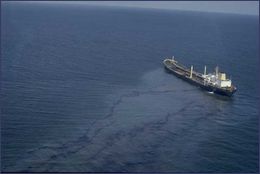
The Alvenus tanker and oil slick. NOAA |
| 73 | Julius Schindler
Oil spilled: 8,200 tonnes
In gallons: 2,525,600
In barrels: 60,106
Date: 11 Feb 1969
Location: Ponta Delgado, Azores
Type: Oil tanker
Cause: Unknown
| This spill has been included here because it shows up on many of the Biggest Oil Spill lists on the internet. The real amount of oil spilled appears to have been relatively small - about 10% of the commonly listed amount. Very little other information can be found about this incident.
References: [1] [2] [3] | 
|
| 74 | Barge Cibro Savannah
Oil spilled: 2,300 tonnes
In gallons: 708,400
In barrels: 16,859
Date: 6 Mar 1990
Location: Linden, New Jersey
Type: Cargo barge
Cause: Explosion
| The Barge Cibro Savannah exploded as it was being pulled from the dock at Linden, New Jersey on March 6th, 1990. In total 710,000 gallons of fuel oil were either spilled into the sea or lost in the fire.
References: [1] | 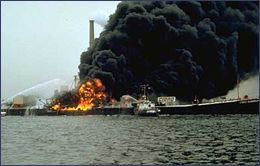
The Barge Cibro Savannah burning. (NOAA) |
| 75 | Bunga Kelana 3
Oil spilled: 2,000 - 2,500 tonnes
In gallons: 616,000 - 770,000
In barrels: 14,660 - 18,325
Date: 25 May 2010
Location: Singapore Strait
Type: Oil tanker
Cause: Ship collision
| The tanker Bunga Kelana 3 collided with the bulk carrier MV Waily in the busy Singapore Strait on May 25, 2010. The collision created a ten meter gash in one of the tanks of the Bunga Kelana 3, and over 2,000 tonnes of light crude oil spilled into the sea. The tanker was carrying 62,000 tonnes of oil in total.
References: [1] [2] | 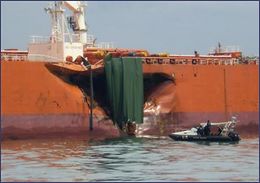
The hole in the side of the Bunga Kelana 3. |
| 76 | OCP Trans-Andean Pipeline
Oil spilled: 1,910 tonnes
In gallons: 588,280
In barrels: 14,000
Date: 24 Feb 2009
Location: Santa Rosa river, Ecuador
Type: Pipeline
Cause: Leak
| The trans-Andean Heavy Crude pipeline ruptured in February 2009. Roughly 14,000 barrels of crude oil spilled into the Santa Rosa river, which drains into the Amazon. According to eye witness "the river was completely covered with oil from bank to bank", and 18 miles of riverside was contaminated.
References: [1] [2] [3] | 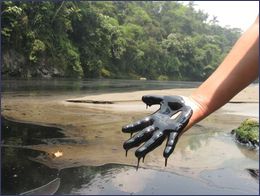
Oil on the river in the Ecuador rainforest.
Amazon Watch |
| 77 | Xingang Port
Oil spilled: 1,500 - 1,600 tonnes
In gallons: 462,000 - 492,800
In barrels: 10,995 - 11,728
Date: 16 Jul 2010
Location: Dalian, Liaoning, China
Type: Pipeline
Cause: Rupture
| Two crude oil pipelines exploded in the Chinese port of Xingang on July 16 2010. A fire burned for 15 hours, and over 400,000 gallons of oil spilled into the sea. The slick covered at least 430 square kilometers, and contaminated beaches and port areas. One firefighter drowned in the oil after falling from a ship during the cleanup operations.
References: [1] [2] [3] | 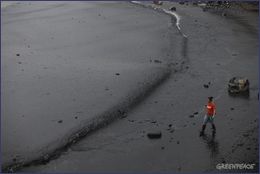
Oiled beach in Dalian. Greenpeace |
| 78 | MS Olivia
Oil spilled: 1,400 - 1,500 tonnes
In gallons: 431,200 - 462,000
In barrels: 10,262 - 10,995
Date: 16 Mar 2011
Location: Nightingale Island, South Atlantic
Type: Cargo ship
Cause: Grounded
| The cargo vessel MS Oliva ran aground on the remote Nightingale Island on 16th March 2011, carrying 60,000 tonnes of soya beans. The 22 crew onboard could be rescued, but about 1500 tonnes of fuel oil was spilled as the vessel began to break up in the days after. The island is free from mammals and is an important colony for the endangered Northern Rockhopper Penguin, home to 40% of all remaining birds. Days later the oil slick could be seen around the entire island, and hundreds of oiled penguins were found. The penguins and other nesting seabirds could also be at risk from rats escaping from the vessel.
References: [1] [2] [3] | 
|
| 79 | Volgoneft-139
Oil spilled: 1,200 - 1,300 tonnes
In gallons: 369,600 - 400,400
In barrels: 8,796 - 9,529
Date: 11 Nov 2007
Location: Strait of Kerch, Ukraine and Russia
Type: Oil tanker
Cause: Broke in two in bad weather
| A violent storm on the Black Sea on November 11th, 2007 sank at least five ships. One of the ships was the tanker Volgoneft-139 which broke in half in the high seas. At least 13,000 tonnes of oil was spilled in the Kerch strait between the Black Sea and the Sea of Azov.
Other ships which sank in the same storm carried thousands of tonnes of sulphur to the bottom.
References: [1] [2] [3] | 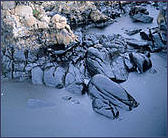
Black sea oil spill. (WWF) |
| 80 | Barge Bouchard 155
Oil spilled: 1,090 tonnes
In gallons: 335,720
In barrels: 7,990
Date: 10 Aug 1993
Location: Tampa Bay, Florida, US
Type: Cargo barge
Cause: 3 ship collision
| Barge Bouchard 155, the freighter Balsa 37 and barge Ocean 255 all collided west of the Skyway Sunshine Bridge in the morning of August 10, 1993. The jet fuel and gasoline onboard the Ocean 255 caught fire and the Bouchard 155 spilled approximately 8,000 barrels of oil into Tampa Bay. Oil covered mangrove islands in Boca Ciega Bay, oyster and seagrass beds, as well as tidal mud flats and many miles of sand beaches. In total over 50 kilometers (30 miles) of shoreline was oiled by this spill.
References: [1] | 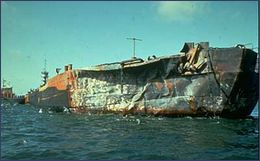
Barge Bouchard 155 after the collision. (NOAA) |
| 81 | Solar I
Oil spilled: 172 - 1,540 tonnes
In gallons: 52,976 - 474,320
In barrels: 1,261 - 11,288
Date: 11 Aug 2006
Location: Guimaras Strait, Philippines
Type: Oil tanker
Cause: Sank in bad weather
| The Solar I tanker sank in bad weather on August 11th, 2006 near the island of Guimaras, Philippines. 1,000 hectares of mangrove forest were affected by the oil spill, including areas in the Taclong Island Sanctuary. Coral reefs were also badly affected, with the spill damaging fishing grounds and polluting dive spots including a national marine reserve.
Villagers on Guimaras island noticed skin and breathing problems following the spill. One man died after breathing in the toxic fumes from the thick, tar-like substance outside his home.
References: [1] [2] [3] [4] | 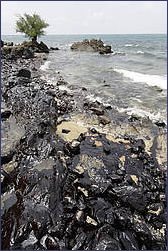
Oil on the coast of Sitio Nauway Island in the Philippines. (WWF) |
| 82 | Prudhoe Bay oil spill
Oil spilled: 690 - 867 tonnes
In gallons: 212,520 - 267,036
In barrels: 5,058 - 6,355
Date: 2 Mar 2006
Location: Prudhoe Bay, Alaska
Type: Pipeline
Cause: Leak
| In March 2006 over 200,000 gallons of oil leaked from a 6mm hole in one of BP's pipelines in the Alaskan North Slope. It is one of the largest spills on the North Slope, and BP pleaded guilty to criminal negligence and paid 20 million dollars in fines.
References: [1] [2] | 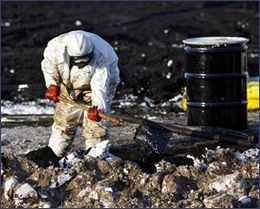
Cleanup operations at the Prudhoe Bay oil field. |
| 83 | Jessica
Oil spilled: 568 - 686 tonnes
In gallons: 174,944 - 211,288
In barrels: 4,163 - 5,028
Date: 16 Jan 2001
Location: Near Baquerizo Moreno, San Cristobal Island, Galapagos
Type: Oil tanker
Cause: Ran aground
| The oil tanker Jessica ran aground about 800 meters from Baquerizo Moreno on San Cristobal in the Galapagos Islands. After two days the ship started leaking oil, following several failed attempts to refloat the ship. Oil shortly reached the beaches on San Cristobal island and later the islands of Santa Fé, Santa Cruz and as far away as Isabela.
The Galapagos islands are a national park and World Heritage site with many unique and endemic species. The cleanup operation, combined with favorable wind and current, helped avoiding an unprecedented environmental disaster in the archipelago. However the accident still caused a decline in the populations of sea lions and marine iguanas on San Cristobal and Santa Fé islands for the year 2001, and many sea birds were also affected.
References: [1] [2] [3] | 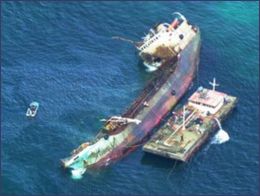
The tanker Jessica leaking oil after running aground in Galapagos. (NASA) |
| 84 | Othello
Oil spilled: 200 - 300 tonnes
In gallons: 61,600 - 92,400
In barrels: 1,466 - 2,199
Date: 20 Mar 1970
Location: Trälhavet Bay, Sweden
Type: Oil tanker
Cause: Ship collision
| The Othello (or Otello) spill has been included here because it shows up on many of the Biggest Oil Spill lists on the internet. Several sources report this spill size to be as large as 18.3 million, or even 30.7 million gallons. In other databases it is listed as small as 25,000 gallons. The most realistic figures appear to be around 60-90,000 gallons or 200-300 tonnes.
References: [1] [2] | 
|
| 85 | Cosco Busan
Oil spilled: 188 tonnes
In gallons: 57,904
In barrels: 1,378
Date: 7 Nov 2007
Location: San Francisco Bay
Type: Container ship
Cause: Bridge collision
| The container ship COSCO Busan collided with the San Francisco-Oakland Bay Bridge on November 7th, 2007 in thick fog. 58,000 gallons of bunker fuel was spilled into San Francisco Bay, affecting marine life and forcing over 20 public beaches to be closed. About 2,150 oiled birds were found dead or dying, and wildlife biologists estimated that in total over 20,000 birds may have died in the disaster.
References: [1] [2] | 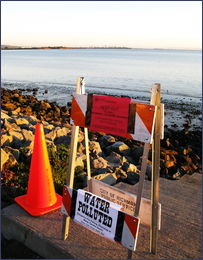
The Richmond Marina Bay shoreline closed due to oil contamination. (Wikipedia) |
|
 Open Google Earth file
Open Google Earth file
 Preview in the Google Earth Plugin
Preview in the Google Earth Plugin



















































